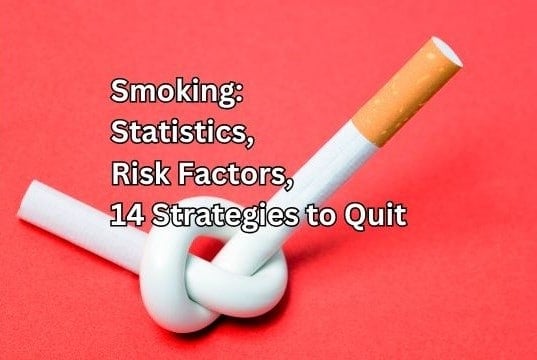
If you’re tired of playing the “kick the habit game” and want to stop smoking once and for all, this article is for you. One thousand six hundred words of eye-opening statistics, documented evidence, and words to the wise will offer you hope, and provide you with the key to beat nicotine addiction.
Smoking statistics
Statistically, addiction to smoking increases the user’s chance of having their life end prematurely by as much as 50 percent due to risks associated with smoking. That is a staggering realization. Add to that, many users of tobacco products knew that there was a health risk at the time they picked up the habit.
User statistics are equally as disturbing:
- One in five high school seniors admit to being addicted to tobacco.
- 70% of all high school students admit to having tried cigarettes.
- Statistically speaking, 3,000 teenagers start smoking each day.
- In 2022, 49.2 million (19.8%)—or nearly 1 in 5—U.S. adults reported current tobacco product use.
- Eightly percent of all smokers picked up the habit before age 21.
- At least 625,000 Americans lose their life each year from tobacco use.
- Women who smoke up to half a pack of cigarettes a day during pregnancy increase their risk of delivering a baby with webbed or missing fingers and toes by 29 percent. The more cigarettes that are smoked, the higher the risk. Women who smoked 21 or more cigarettes increased the risk by 78%.
- Smokers in their 30s and 40s are five times more likely to have a heart attack than nonsmokers in the same age group.
- Ninety percent of all schizophrenic patients smoke, 70 percent of all manic-depressive patients smoke, and ninety of all alcoholics smoke.
- More than 4 million people lose their lives each year due to smoking. It is estimated that the figure will rise to 10 million by the year 2030 due in part to increased use of tobacco in developing countries.
In addition to the above, research indicates that there is a strong link between cigarette smoking and socio-economic classification. Whereas nearly one-third of men and women in routine, manual (blue-collar) occupations smoked, less than one-fourth of all persons in management and professional occupations smoked. In fact, 44 percent of persons in blue-collar positions started smoking before they were 16, compared to only 29 percent of persons in professional occupations.
A Surgeon General’s report included the statement, “Smoking harms nearly every organ of your body, causing many diseases, and reducing your health in general.”
Health risks factors
Smoking not only harms the body in many ways, but it also damages the immune system, increasing the risk of infection. Illnesses in smokers also last longer than in nonsmokers. Smokers have a lower survival rate after surgery and are more likely to experience health complications such as pneumonia and other respiratory problems.
A host of other possible health hazards await the habitual smoker. Increased bladder problems, claudication (a mobility inhibiting disorder), heart disease, high blood pressure, high cholesterol, osteoporosis, stomach and other ulcers, varicose veins, premature wrinkles, and stroke risks can all be attributed to smoking. Taste and smell also become impaired, and menopause complications are greater.
Smokers’ bones are less dense, increasing the chances of hip and other fractures as the body ages. Peripheral artery disease affecting the blood flow is another serious health hazard. And, of course, the well-known risks of various cancers associated with smoking, which are many.
And those who smoke cigarettes, vapes, cigars, and pipes are not alone. Recent studies documented in the Journal of the National Cancer Institute reveal that chewing snuff is as dangerous a habit, or even more, than smoking. Top-name snuff brands yield high levels of toxic chemicals called “nitrosamines.” Those who chew snuff get twice as much of the harmful chemicals found in processed tobacco products as those who smoke a pack of cigarettes a day.
Once acquired, the smoking habit is hard to kick. While campaigns to prevent others from falling prey to the “toxic” habit of smoking, ways to help those already hooked require equal attention.
As distressing and well-known the risks associated with tobacco use are, and as much as those who do smoke want to quit, “snuffing out the habit” proves more difficult than expected. The game of “one step forward, two steps back” is played out as repeated attempts to kick the smoking habit are met with failure.
But smokers who want to quit have reason to be greatly encouraged, and their efforts to stop smoking fortified. One other statistic with a more positive note should be added to the list of the negatives compiled for cigarette smokers. And that is this: “100 percent of all persons who smoke started out life as non-smokers.”
Realizing the weight and worth of that statement is vital in the battle against defeat. Every smoker who wants to stop but feels incapable of doing so needs to remember an important fact. If they were a nonsmoker once, they could be a nonsmoker again.
14 Strategies to quit smoking
It is possible for people to kick the smoking habit successfully. While each person and each situation varies, following these tried and true approaches to stop smoking will increase chances of success:
- First and foremost, DECIDE that you want to quit smoking. Many attempts to quit smoking fail simply because others have pressured the person to do so. The smoker must be the one to decide that they want to quit.
- Think positive. Don’t sabotage your efforts by dwelling on thoughts about how difficult it will be. Instead, focus on all the good reasons to quit smoking. Making a list of reasons why you want to quit will help. Carry the list with you at all times; whenever you have the urge to smoke, looking over the list will help fortify your decision and motivate you.
- Remove smoking paraphernalia from your life. Make a clean sweep of your home, office, car, purse…every nook and cranny. Launder your clothes to remove the smell of smoke. Get rid of ashtrays, lighters, and everything associated with the habit.
- Request the support of family and friends. Success can greatly increase when family members, friends, and coworkers know you want to stop smoking. Not only can they help encourage you, but the risk of giving into temptation and sneaking a smoke is reduced when you have made yourself accountable to others.
- Make your environment smoke-free. Do not allow other persons to smoke in your house or your car. Try to avoid being around people who smoke as much as possible.
- Change your daily routine. If you were in the habit of sitting up in bed and lighting up a cigarette upon first waking up, get out of bed as soon as you do wake up. If you lingered over coffee and a cigarette after eating, get up from the table as soon as you’ve finished your meal. Some people find that rearranging their furniture, sitting at a different place at the table, sleeping on the other side of the bed, and seeking out new social environments all helped break old habits and reduce their urge to smoke.
- Avoid situations you associate with smoking. For the first 1 – 3 weeks, avoid going to places and doing things that remind you of “pleasurable” smoking: a cocktail before dinner, happy hour at a popular bar or other social situations where people smoke, or even sitting back in your recliner to watch a favorite program can all trigger the urge to smoke.
- Cut back on alcohol and caffeinated beverages. Drink lots of water to help flush toxins from your body. Carry a water bottle with you at all times.
- Plan ahead on ways to deal with temptation. Eating small, frequent meals will help to stabilize your blood sugar. Snacks such as carrot sticks, sunflower seeds, apples, pickles, raisins, gum, lollipops, and hard candy are all good substitutes when you feel the urge to smoke. A stress ball, doodle pad, or pack of cards helps to keep hands busy when the urge to reach for a cigarette strikes.
- Do something physical. Activities such as taking a walk, exercising, dancing, swimming, playing a sport, etc., help when you get angry, stressed, or bored—times when you would ordinarily have lit up a cigarette.
- Learn to relax. Relaxation exercises are a great way to replace the urge to smoke. Get away from the problems and pressures. Take a 5-minute break, close your eyes, and breathe deeply. Make yourself go limp. Imagine a soothing, pleasing situation. Concentrate on that peaceful image and nothing else.
- Spend more time around persons who don’t smoke—especially those who have successfully kicked the habit.
- Discover new hobbies and activities. Find new ways to relax and spend spare time alone and with others—new recreation interests that will complement your new smoke-free life!
- Don’t get discouraged if you do slip and smoke. Be committed to follow steps 1 – 13, but if you do slip, don’t get discouraged. Many former smokers had to make several attempts before realizing success. The urge to smoke and other “withdrawal symptoms” are temporary, and usually disappear after only 1 or 2 weeks. Most relapses occur within the first week after quitting. Get beyond that point, and you are halfway there.
By educating yourself on the hazards of smoking, making a sound commitment to kick the habit, and by following these 14 “tried-and-true” tips, you are well on your way to a happier future. With each passing year of smoke-free living, your body becomes stronger and healthier, and your future more risk-free.


